Alumni
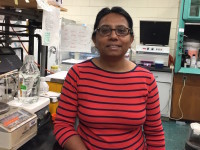
Arpita Ghosh
2017-2025
(Graduate Student)
Arpita initially joined the lab as a Research Associate, and she enrolled in the graduate program in 2021. She graduated with her PhD in August 2025. Her main project centered on determining the substrate for the Agrobacterium fabrum efflux pump PecM, finding that it exports the plant exudate and metabolic intermediate 4-hydroxybenzaldehyde. In absence of PecM, the cells undergo marked metabolic changes and exhibit increased resistance to oxidative stress as determined in part by transciptomics and proteomics.
Publications:
Ghosh, A. and Grove, A. 2025. The Agrobacterium fabrum efflux pump PecM is produced in response to the plant exudate 4-hydroxybenzaldehyde to avoid disruption of central metabolism. J. Bacteriol. 207, e00150-25.
Hickman, A. B., Lannes, L., Furman, C. M., Hong, C., Franklin, L., Ghirlando, R., Ghosh, A., Luo, W., Konstantinidou, P., Lorenzi, H.A., Grove, A., Haase, A., Wilson, M. H. and Dyda, F. 2025. The activity of the mammalian DNA transposon piggyBat from Myotis lucifugus is restricted by its own transposon ends. Nat. Commun. 16, 458.
Nwokocha, G., Ghosh, A. and Grove, A. 2024. Regulation of bacterial virulence genes by PecS family transcription factors. J. Bacteriol. 206, e00302-24.
Sivapragasam, S., Ghosh, A., Kumar, S., Johnson, D. T. and Grove, A. 2021. Similar solutions to a common challenge: Regulation of genes encoding Ralstonia solanacearum xanthine dehydrogenase. FEMS Microbiol. Lett. 368, fnab022.
Natalie Venkataraman
2025
(Undergraduate Student)
Natalie was involved in a project aiming to determine substrates for an Agrobacterium fabrum efflux pump.

Kaedyn Baker
2024-2025
(Undergraduate Student)
Kaedyn's project focused on determining the role of cysteine residues in the super-repressor phenotype of BifR in Burkholderia thailandensis, a project that culminated in an Honors Thesis. Kaedyn graduated in May 2025 with plans of attending medical school.
Aaroh Desai
2022-2024
(Undergraduate Student)
Aaroh was working on a project concerning the yeast transcription factor Crf1p. Aaroh left to pursue his interest in computer science.
 Sanjay Kumar
Sanjay Kumar
2017-2024
(Graduate Student/Postdoctoral Researcher)
Sanjay discovered that the yeast transcription factor Crf1p acts as an activator, a function that is particularly important under conditions when the Target of Rapamycin Complex I (mTORC1) is inhibited. Sanjay graduated in 2023 and stayed in the lab for a short while before accepting a postdoctoral position.
Publications:
Kumar, S., Mashkoor, M., Balamurugan, P. and Grove, A. 2024. Yeast Crf1p is an activator with different roles in regulation of target genes. Yeast 41, 379-400.
Kumar, S., Mashkoor, M. and Grove, A. 2022. Yeast Crf1p: An activator in need is an activator indeed. Comp. Struct. Biotechnol. J. 20, 107-116.
Sivapragasam, S., Ghosh, A., Kumar, S., Johnson, D. T., Grove, A. 2021. Similar solutions to a common challenge: Regulation of genes encoding Ralstonia solanacearum xanthine dehydrogenase. FEMS Microbiol. Lett. 368, fnab022.
 Ruth Adams
Ruth Adams
2023
(Undergraduate Student)
Ruth was working on a project related to regulation of genes encoding nucleoid-associated proteins in Burkholderia thailandensis. Ruth transferred to University of Maryland.
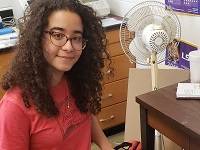 Hannah Elkholy
Hannah Elkholy
2019-2023
(Undergraduate Student)
Hannah contributed to the characterization of two bacterial transcription factors. She graduated in December 2023 with plans of enrolling in Medical School; she was accepted to LSUHSC New Orleans.
Publications:
Nwokocha, G. C.,* Bhattacharyya, N.,* LeBoeuf, E. N., Elkholy, H. and Grove, A. 2025. DNA distortion by the Burkholderia thailandensis transcriptional regulator FusR2 is abolished by fusaric acid binding. Biochemistry, 64, 4682-4691. *Equal contribution.
Nwokocha, G. C., Adhikari, P., Iqbal, A., Elkholy, H., Doerrler, W. T., Larkin, J. C. and Grove, A. 2023. Transcription factor PecS mediates Agrobacterium fabrum fitness and survival. J. Bacteriol. 205, e0047822.
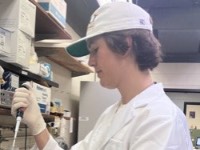
Bryce Stevens
2022-2023
(Undergraduate Student)
Bryce participated in the generation of a B. thailandensis strain in which the gene encoding the transcription factor CysB is disrupted. He left in May 2023 to pursue other interests.

George Nwokocha
2017-2023
(Graduate Student)
George characterized the transcription factor PecS from Agrobacterium fabrum. He found that PecS controls a number of phenotypes associated with the transition of A. fabrum from the rhizosphere to the host environment. George graduated in May 2023 and accepted a position at Corteva Agriscience, Johnston, IA.
Publications:
Nwokocha, G. C.,* Bhattacharyya, N.,* LeBoeuf, E. N., Elkholy, H. and Grove, A. 2025. DNA distortion by the Burkholderia thailandensis transcriptional regulator FusR2 is abolished by fusaric acid binding. Biochemistry, 64, 4682-4691. *Equal contribution.
Nwokocha, G., Ghosh, A. and Grove, A. 2024. Regulation of bacterial virulence genes by PecS family transcription factors. J. Bacteriol. 206, e00302-24.
Iqbal, A., Nwokocha, G., Barphagha, I. K., Grove, A., Ham, J. H., and Doerrler, W. T. 2023. A membrane protein of the DedA superfamily establishes a link between proton motive force and quorum sensing of Burkholderia glumae. Mol. Plant Pathol. 24, 1400-1413.
Nwokocha, G. C., Adhikari, P., Iqbal, A., Elkholy, H., Doerrler, W. T., Larkin, J. C. and Grove, A. 2023. Transcription factor PecS mediates Agrobacterium fabrum fitness and survival. J. Bacteriol. 205, e0047822.
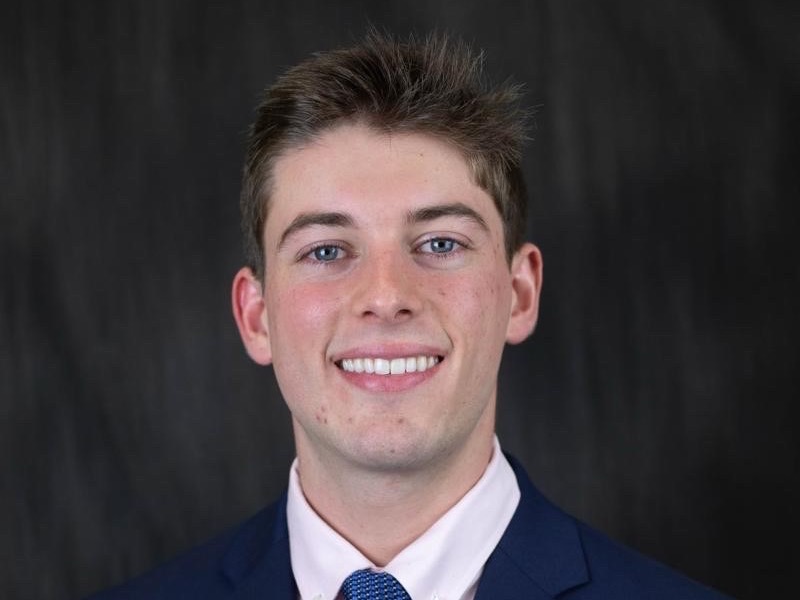
Jean-Paul LeMaire
2021-2023
(Undergraduate Student)
JP was working on a project aiming to determine how the B. thailandensis transcription factor BifR responds to oxidative stress. He graduated in May 2023 with plans of attending Medical School.
 Will delaBretonne
Will delaBretonne
2017-2021
(Undergraduate Student)
Will's project was to determine the substrates for the B. thailandensis efflux pump MftP. He left to pursue his interest in agricultural research.
 Sudarshan Thapa
Sudarshan Thapa
2016-2020
(Graduate Student)
Sudh discovered that the antibiotic trimethoprim causes Burkholderia thailandensis to accumulate xanthine, a result of which is increased expression of various genes associated with bacterial fitness and virulence. He also contributed to an understanding of the mechanisms by which the global transcriptional regulator MftR controls gene expression. Sudh graduated in December 2020. He accepted a Senior Scientist position at PPD, part of Thermo Fisher Scientific, Richmond, VA, where he was quickly promoted to Associate Group Leader.
Publications:
Thapa, S. S., Al-Tohamy, A., Grove, A. 2022. The global regulator MftR controls virulence and siderophore production in Burkholderia thailandensis. J. Bacteriol. 204, e0023722.
Thapa, S. S. and Grove, A. 2021. Impaired purine homeostasis plays a primary role in trimethoprim-mediated induction of virulence genes in Burkholderia thailandensis. Mol. Microbiol. 115, 610-622.
Thapa, S. S. and Grove, A. 2019. Do global regulators hold the key to production of bacterial secondary metabolites? Antibiotics 8, 160.
Gupta, A., Pande, A., Sabrin, A., Thapa, S. S., Gioe, B. W. and Grove, A. 2019. MarR family transcription factors from Burkholderia species: Hidden clues to control of virulence-associated genes. Microbiol. Mol. Biol. Rev. 83, e00039-18.
Gupta, A., Bedre, R, Thapa, S. S., Sabrin, A., Wang, G., Dassanayake, M. and Grove, A. 2017. Global awakening of cryptic biosynthetic gene clusters in Burkholderia thailandensis. ACS Chem. Biol. 12, 3012-3021.
 Tiffany Dang
Tiffany Dang
2019-2020
(Undergraduate Student)
Tiffany was working on a project pertaining to the role of the rapamycin receptor FKBP12 in yeast.
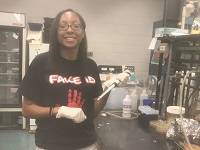 Kennedy Goins
Kennedy Goins
2019-2020
(Graduate Student)
Kennedy was working on a project pertaining to antibiotic resistance in B. thailandensis. The COVID pandemic forced her to change her plans.
 Mathew Smith
Mathew Smith
2017-2020
(Graduate Student)
Mat's project concerned mechanisms by which expression of the gene encoding yeast HMO1 is regulated during stress. Mat graduated in May 2020 and accepted a position as Formulation Scientist at Thermo Fisher Scientific in Pleasanton, CA. In 2021, he moved to Loop Genomics, San Jose, CA.
Publication:
Panday, A., Gupta, A., Srinivasa, K., Xiao, L., Smith, M. D. and Grove, A. 2017. DNA damage regulates direct association of TOR kinase with the RNA polymerase II-transcribed HMO1 gene. Mol. Biol. Cell. 28, 2449-2459.
Brennan Gioe
2016-2019
(Undergraduate Student)
Brennan contributed to the characterization of the MarR family transcription factor OstR from Burkholderia thailandensis. Brennan graduated in December 2019, and he was accepted to Medical School at LSUHSC Shreveport.
Publications:
Sabrin, A., Gioe, B. W., Gupta, A. and Grove, A. 2019. An EmrB multidrug efflux pump in Burkholderia thailandensis with unexpected roles in antibiotic resistance. J. Biol. Chem. 294, 1891-1903.
Gupta, A., Pande, A., Sabrin, A., Thapa, S. S., Gioe, B. W. and Grove, A. 2019. MarR family transcription factors from Burkholderia species: Hidden clues to control of virulence-associated genes. Microbiol. Mol. Biol. Rev. 83, e00039-18.
Presentation:
Gioe, B., Sabrin, A. and Grove, A. Regulation of emrB by redox-sensitive MarR homologue BTH_I0021 in Burkholderia thailandensis. ASM Microbe 2018. Atlanta, GA. June 2018.

Parvathy Balamurugan
Summers 2015, 2017, 2019
(High School/Undergraduate Student)
Parvathy participated in different research projects, most recently in the characterization of a transcription factor from the shrimp pathogen Vibrio nigripulchritudo and its role in gene regulation and oxidative stress responses. She started college in 2018 at Johns Hopkins University.
Presentation:
Delacroix, B., Bhattacharyya, N., Balamurugan, P., Balamurugan, P. and Grove, A. Understanding the regulatory mechanism of PecS in Vibrio nigripulchritudo. South Central Branch ASM Annual Meeting. Little Rock, AR. October, 2017.
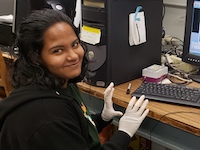 Priya Balamurugan
Priya Balamurugan
Summers 2015, 2017, 2019
(High School/Undergraduate Student)
Priya's most recent research project concerned the mechanism by which the mechanistic Target of Rapamycin (mTORC1) mediates control of target gene expression in Saccharomyces cerevisiae in response to stress. She started college in 2018 at Johns Hopkins University.
Publication:
Kumar, S., Mashkoor, M., Balamurugan, P. and Grove, A. Yeast Crf1p is an activator with different roles in regulation of target genes. 2024. Yeast 41, 379-400.
Presentations:
Kumar, S., Mashkoor, M., Balamurugan, P. and Grove, A. Role of CURI complex in regulation of mTORC1 target genes under DNA damage stress. Virtual Keystone Symposia – Genomic Stability and DNA Repair. September 2020.
Kumar, S., Balamurugan, P. and Grove, A. Role of Curi Complex in Regulation of mTORC1 Target Genes Under Stress and Starvation. ASCB|EMBO Meeting. Washington, DC. December 2019. P349.
Delacroix, B., Bhattacharyya, N., Balamurugan, P., Balamurugan, P. and Grove, A. Understanding the regulatory mechanism of PecS in Vibrio nigripulchritudo. South Central Branch ASM Annual Meeting. Little Rock, AR. October, 2017.
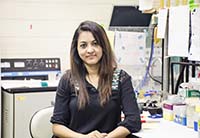 Afsana Sabrin
Afsana Sabrin
2015-2019
(Graduate Student/Postdoctoral Researcher)
Afsana characterized the MarR-family transcription factor OstR from B. thailandensis. She proposed a novel mechanism by which it responds to oxidant and characterized its regulation of a gene encoding an EmrB efflux pump. She also demonstrated that EmrB is a primary exporter of the clinically important antibiotic trimethoprim. Afsana graduated in May 2019. After completing postdoctoral research, Afsana joined EvolveImmune Therapeutics, Branford, CT in 2023.
Publications:
Sabrin, A., Gioe, B. W., Gupta, A. and Grove, A. 2019. An EmrB multidrug efflux pump in Burkholderia thailandensis with unexpected roles in antibiotic resistance. J. Biol. Chem. 294, 1891-1903.
Gupta, A., Pande, A., Sabrin, A., Thapa, S. S., Gioe, B. W. and Grove, A. 2019. MarR family transcription factors from Burkholderia species: Hidden clues to control of virulence-associated genes. Microbiol. Mol. Biol. Rev. 83, e00039-18.
Gupta, A., Bedre, R, Thapa, S. S., Sabrin, A., Wang, G., Dassanayake, M. and Grove, A. 2017. Global awakening of cryptic biosynthetic gene clusters in Burkholderia thailandensis. ACS Chem. Biol. 12, 3012-3021.
 Blake Delacroix
Blake Delacroix
2017-2019
(Undergraduate Student
Blake was aiming to understand mechanisms by which the pathogenic Vibrio species V. nigripulchritudo responds to oxidative stress. Blake graduated in May 2019 and was accepted to Medical School at LSUHSC Shreveport.
Presentation:
Delacroix, B., Bhattacharyya, N., Balamurugan, P., Balamurugan, P. and Grove, A. Understanding the regulatory mechanism of PecS in Vibrio nigripulchritudo. South Central Branch ASM Annual Meeting. Little Rock, AR. October, 2017.
 Anuja Pande
Anuja Pande
2012-2019
(Graduate Student/Postdoctoral Researcher)
Anuja analyzed gene regulation by the B. thailandensis transcription factor OhrR, and she deduced the mechanism by which OhrR responds to both organic and inorganic oxidants. A particularly notable observation was that both OhrR and organic hydroperoxides contribute to virulence. Anuja graduated in 2018 and stayed in the lab as a postdoctoral researcher. After working for a few years at SRI International in Harrisonburg, VA, Anuja joined Cystic Fibrosis Foundation Therapeutics in 2023.
Publications:
Deochand, D. K., Pande, A., Meariman, J. K. and Grove, A. 2019. Redox-sensing by PecS from the plant pathogen Pectobacterium atrosepticumand its effect on gene expression and the conformation of PecS-bound promoter DNA. Biochemistry 58, 2564-2575.
Gupta, A., Pande, A., Sabrin, A., Thapa, S. S., Gioe, B. W. and Grove, A. 2019. MarR family transcription factors from Burkholderia species: Hidden clues to control of virulence-associated genes. Microbiol. Mol. Biol. Rev. 83, e00039-18.
Pande, A., Veale, T. C. and Grove, A. 2018. Gene regulation by redox-sensitive Burkholderia thailandensis OhrR and its role in bacterial killing of Caenorhabditis elegans. Infect. Immun. 86, e00322-18.
Vidanapathirana, P., Hasan, F., Mussio, K., Pande, A., Brands, M., Siraj, N., Grove, A. and Warner, I. M. 2017. Cationic Ionic Liquid Surfactant-Polyacrylamide Gel Electrophoresis for Enhanced Separation of Acidic and Basic Proteins with Single-Step Ribonuclease b Glycoforms Separation. J. Chromatogr. A 1515, 245-251.
Sivapragasam, S., Pande, A. and Grove, A. 2015. A recommended workflow for DNase I footprinting using a capillary electrophoresis genetic analyzer. Anal. Biochem. 481, 1-3.
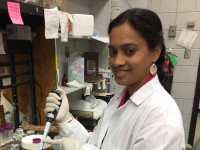 Smitha Sivapragasam
Smitha Sivapragasam
2012-1016; 2018-2019
(Graduate Student/Postdoctoral Researcher)
Smitha discovered a novel link between synthesis of the alarmone (p)ppGpp and purine salvage. She reported that the transcription factor XdhR, which controls expression of genes encoding the purine salvage enzyme xanthine dehydrogenase, is a direct target for (p)ppGpp. This results in a feed-back loop in which (p)ppGpp promotes purine salvage, which in turn promotes GTP and (p)ppGpp synthesis. Smitha graduated in August 2015. After a few years as a postdoctoral researcher, Smitha accepted an appointment as Research Assistant Professor at University of South Florida.
Publications:
Sivapragasam, S., Ghosh, A., Kumar, S., Johnson, D. T., Grove, A. Similar solutions to a common challenge: Regulation of genes encoding Ralstonia solanacearum xanthine dehydrogenase. FEMS Microbiol. Lett. 368, fnab022 (2021).
Sivapragasam, S. and Grove, A. 2019. The link between purine metabolism and production of antibiotics in Streptomyces. Antibiotics 8, 76.
Sivapragasam, S., Deochand, D. K., Meariman, J. K. and Grove, A. 2017. Stringent response induced by phosphate limitation promotes purine salvage in Agrobacterium fabrum. Biochemistry 56, 5831-5843.
Sivapragasam, S. and Grove, A. 2016. Determination of (p)ppGpp Levels During Stringent Response in Streptomyces coelicolor by Thin Layer Chromatography. Bio-protocol. 6(21):e1995.
Sivapragasam, S. and Grove, A. 2016. Streptomyces coelicolor XdhR is a direct target of (p)ppGpp that controls expression of genes encoding xanthine dehydrogenase to promote purine salvage. Mol. Microbiol. 100, 701-718.
Sivapragasam, S., Pande, A. and Grove, A. 2015. A recommended workflow for DNase I footprinting using a capillary electrophoresis genetic analyzer. Anal. Biochem. 481, 1-3.
Huang, H., Sivapragasam, S. and Grove, A. 2015. The regulatory role of Streptomyces coelicolor TamR in central metabolism. Biochem. J. 466, 347-358.
Davida Crossley
2018
(Faculty – LSU-A)
As a participant in the LSU-LBRN summer program, Davida was aiming to characterize patterns of M46 gene expression in the pathogenic fungus Histoplasma capsulatum.
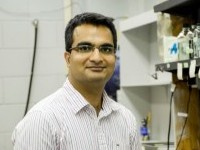 Ashish Gupta
Ashish Gupta
2011-2017
(Graduate Student/Postdoctoral Researcher)
Ashish characterized MftR and BifR, two transcription factors from Burkholderia thailandensis. He determined that the redox-sensitive BifR suppresses biofilm formation and he identified the MftR regulon, discovering that MftR is a global regulator of biosynthetic gene clusters. He also contributed to our discovery that TOR kinase binds directly to the HMO1 gene. Ashish graduated in December 2016 and stayed in the lab as a postdoctoral researcher. In 2017, Ashish accepted a Scientist position at Novavax, Rockville, MD. He joined Biocon, Bangalore, India, as Associate Scientific Manager in 2019.
Publications:
Sabrin, A., Gioe, B. W., Gupta, A. and Grove, A. 2019. An EmrB multidrug efflux pump in Burkholderia thailandensis with unexpected roles in antibiotic resistance. J. Biol. Chem. 294, 1891-1903.
Gupta, A., Pande, A., Sabrin, A., Thapa, S. S., Gioe, B. W. and Grove, A. 2019. MarR family transcription factors from Burkholderia species: Hidden clues to control of virulence-associated genes. Microbiol. Mol. Biol. Rev. 83, e00039-18.
Gupta, A., Bedre, R, Thapa, S. S., Sabrin, A., Wang, G., Dassanayake, M. and Grove, A. 2017. Global awakening of cryptic biosynthetic gene clusters in Burkholderia thailandensis. ACS Chem. Biol. 12, 3012-3021.
Panday, A., Gupta, A., Srinivasa, K., Xiao, L., Smith, M. D. and Grove, A. 2017. DNA damage regulates direct association of TOR kinase with the RNA polymerase II-transcribed HMO1 gene. Mol. Biol. Cell. 28, 2449-2459.
Gupta, A., Fuentes, S. and Grove, A. 2017. Redox-sensitive MarR homologue BifR from Burkholderia thailandensis regulates biofilm formation. Biochemistry 56, 2315-2327.
Panday, A., Xiao, L., Gupta, A. and Grove, A. 2017. Control of DNA end resection by yeast Hmo1p affects efficiency of DNA end-joining. DNA Repair 53, 15-23.
Gupta, A. and Grove, A. 2014. Ligand binding pocket bridges DNA-binding and dimerization domains of the urate-responsive MarR homologue MftR from Burkholderia thailandensis. Biochemistry 53(27), 4368-4380.
 Stanley Fuentes
Stanley Fuentes
2013-2017
(Undergraduate Student)
Stan contributed to the characterization of transcription factor BifR from Burkholderia thailandensis, documenting the relationship between oxidation and DNA binding. Stan earned his MD from LSUHSC, New Orleans and continued as a Psychiatry Resident.
Publication:
Gupta, A., Fuentes, S. and Grove, A. 2017. Redox-sensitive MarR homologue BifR from Burkholderia thailandensis regulates biofilm formation. Biochemistry 56, 2315-2327.
Presentations:
Fuentes, S. C., Gupta, A. and Grove, A. 2016. The Burkholderia thailandensis-encoded MarR homolog, BifR, is redox-sensitive and represses genes related to biofilm formation. ASM Microbe 2016. Boston, MA. June 2016. Recipient of ASM Travel Award.
Fuentes, S. C., Gupta, A. and Grove, A. 2015. The Burkholderia thailandensis-encoded MarR homolog (BTH I0542) participates in oxidative stress responses. 115th American Society for Microbiology General Meeting. New Orleans, LA, May 2015.
 Travis Lindsey
Travis Lindsey
2015-2017
(Undergraduate Student)
Travis' project concerned a transcription factor from Vibrio cholerae that may be involved in controlling biofilm formation. Travis earned his MD from LSUHSC, New Orleans in 2021.
 Jacob Meariman
Jacob Meariman
2015-2017
(Undergraduate Student)
Jacob was working on a transcription factor from the plant pathogen Pectobacterium atrosepticum. He made significant contributions towards understanding how this transcription factor controls gene expression in response to ligand binding or changes in pH. Jacob completed the MD-PhD program at LSUHSC, New Orleans and accepted a residency at Icahn School of Medicine at Mount Sinai..
Publications:
Deochand, D. K., Pande, A., Meariman, J. K. and Grove, A. 2019. Redox-sensing by PecS from the plant pathogen Pectobacterium atrosepticumand its effect on gene expression and the conformation of PecS-bound promoter DNA. Biochemistry 58, 2564-2575.
Sivapragasam, S., Deochand, D. K., Meariman, J. K. and Grove, A. 2017. Stringent response induced by phosphate limitation promotes purine salvage in Agrobacterium fabrum. Biochemistry 56, 5831-5843.
Deochand, D. K., Meariman, J. K. and Grove, A. 2016. pH-dependent regulation of gene expression by Pectobacterium atrosepticum PecS. ACS Chem. Biol. 11, 2049-2056.
 Todd Veale
Todd Veale
2015-2017
(Undergraduate Student)
Todd was focusing on oxidative stress responses in Burkholderia thailandensis, working to understand the mechanism by which the transcription factor OhrR responds to different oxidants. Todd earned his MD from LSUHSC, New Orleans in 2021 and accepted a residency at UAB School of Medicine.
Publication:
Pande, A., Veale, T. C. and Grove, A. 2018. Gene regulation by redox-sensitive Burkholderia thailandensis OhrR and its role in bacterial killing of Caenorhabditis elegans. Infect. Immun. 86, e00322-18.
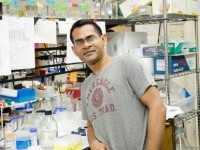 Dinesh Kumar Deochand
Dinesh Kumar Deochand
2011-2016
(Graduate Student)
Dinesh focused on two members of the multiple antibiotic resistance regulator (MarR) family of transcriptional regulators, HucR and PecS. He discovered that low pH regulates HucR function by inducing a molten globule state. He also uncovered a novel mechanism of gene regulation by Pectobacterium atrosepticum PecS in which low pH attenuates PecS-mediated DNA distortion, thus allowing RNA polymerase to compete for promoter binding and transcribe target genes. Dinesh graduated in December 2016 and accepted a postdoctoral position at Hospital for Special Surgery/Weill Cornell Medical College, New York.
Publications:
Deochand, D. K., Pande, A., Meariman, J. K. and Grove, A. 2019. Redox-sensing by PecS from the plant pathogen Pectobacterium atrosepticumand its effect on gene expression and the conformation of PecS-bound promoter DNA. Biochemistry 58, 2564-2575.
Sivapragasam, S., Deochand, D. K., Meariman, J. K. and Grove, A. 2017. Stringent response induced by phosphate limitation promotes purine salvage in Agrobacterium fabrum. Biochemistry 56, 5831-5843.
Deochand, D. K. and Grove, A. 2017. MarR family transcription factors: Dynamic variations on a common scaffold. Crit. Rev. Biochem. Mol. Biol. 52, 595-613.
Deochand, D. K., Perera, I. C., Crochet, R. B., Gilbert, N. C., Newcomer, M. E. and Grove, A. 2016. Histidine switch controlling pH-dependent protein folding and DNA binding in a transcription factor at the core of synthetic network devices. Mol. BioSyst. 12, 2417-2426. Identified as 2016 Hot Article.
Deochand, D. K., Meariman, J. K. and Grove, A. 2016. pH-dependent regulation of gene expression by Pectobacterium atrosepticum PecS. ACS Chem. Biol. 11, 2049-2056.
Kushwaha, A. K., Deochand, D. K. and Grove, A. 2015. A moonlighting function of Mycobacterium smegmatis Ku in zinc homeostasis? Protein Sci. 24, 253-263.
 Arvind Panday
Arvind Panday
2013-2016
(Graduate Student)
Arvind uncovered a novel linker histone-like function of yeast HMO1, showing that this unusual high mobility group protein stabilizes chromatin and is evicted along with core histones in preparation for DNA repair. He was also instrumental in documenting that TOR kinase binds directly to the HMO1 gene. Arvind graduated in December 2016. After completing postdoctoral research, Arvind accepted a position as Assistant Professor at Mayo Clinic in 2023.
Publications:
Panday, A., Gupta, A., Srinivasa, K., Xiao, L., Smith, M. D. and Grove, A. 2017. DNA damage regulates direct association of TOR kinase with the RNA polymerase II-transcribed HMO1 gene. Mol. Biol. Cell. 28, 2449-2459.
Panday, A., Xiao, L., Gupta, A. and Grove, A. 2017. Control of DNA end resection by yeast Hmo1p affects efficiency of DNA end-joining. DNA Repair 53, 15-23.
Panday, A. and Grove, A. 2017. Yeast HMO1 – linker histone reinvented. Microbiol. Mol. Biol. Rev. 81:e00037-16.
Panday, A. and Grove, A. 2016. The high mobility group protein HMO1 functions as a linker histone in yeast. Epigenetics Chromatin 9:13.
Panday, A., Xiao, L. and Grove, A. 2015. Yeast high mobility group protein HMO1 stabilizes chromatin and is evicted during repair of DNA double strand breaks. Nucleic Acids Res. 43, 5759-5770.
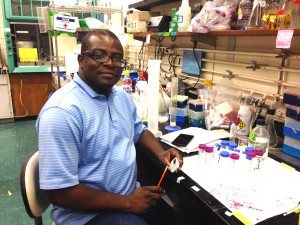 Olabisi Ojo
Olabisi Ojo
Summer 2015
(Faculty – SUNO)
Visiting from Southern University New Orleans as a participant in the LBRN program, Bisi was pursuing his interest in the transcription factor SlyA from E. coli. Bisi joined the faculty at Albany State University, GA, in fall 2015.
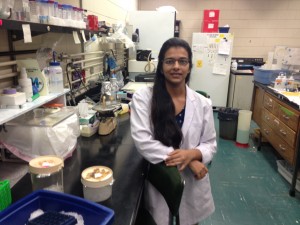 Gagandeep Kaur
Gagandeep Kaur
Summer 2015
(Graduate Student – SUBR)
As a participant in the LBRN program, Gagan was working on her dissertation project focusing on the connection between cigarette smoke and epigenetic markers. Gagan earned her PhD from Southern University, Baton Rouge in December 2019.
 Danté Johnson
Danté Johnson
2013-2015
(Undergraduate Student)
Danté was working on transcription factor XdhR from Ralstonia solanacearum, focusing on its role during starvation and oxidative stress. She graduated in May 2015 and accepted an internship at SC Johnson: A Family Company, following which she enrolled in the Purdue University Post-Baccalaureate Research Education Program in the Biomedical Sciences. In 2022, she earned her PhD from University of Maryland School of Pharmacy, Baltimore.
Publication:
Sivapragasam, S., Ghosh, A., Kumar, S., Johnson, D. T., Grove, A. Similar solutions to a common challenge: Regulation of genes encoding Ralstonia solanacearum xanthine dehydrogenase. FEMS Microbiol. Lett. 368, fnab022(2021).
Presentations:
Johnson, D., Sivapragasam, S. and Grove, A. 2014. Characterization of xanthine dehydrogenase regulator protein of Ralstonia solanacearum, a tomato infecting bacterium. 249th ACS National Meeting, Denver, CO. March 2015. CHED #409.
Johnson, D., Sivapragasam, S. and Grove, A. 2014. Characterization of xanthine dehydrogenase regulator protein of Ralstonia solanacearum, a tomato infecting bacterium. Annual Biomedical Research Conference for Minority Students, San Antonio, TX, November, 2014.
Johnson, D., Sivapragasam, S. and Grove, A. 2014. Characterization of xanthine dehydrogenase regulator protein of Ralstonia solanacearum, a tomato infecting bacterium. 41st Annual NOBCChE Conference, New Orleans, LA, September, 2014.
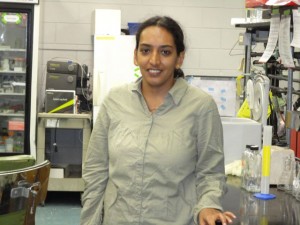 Kavitha Srinivasa
Kavitha Srinivasa
2012-2014
(Postdoctoral Fellow)
Kavitha worked on yeast HMO1, aiming to understand the mechanism by which its expression is controlled in response to signaling by Target of Rapamycin (TOR) kinase. Kavitha accepted a postdoctoral position at the LSU School of Veterinary Medicine in January 2015. After working as a consultant to pharmaceutical companies, Kavitha joined Thermo Fisher Scientific, Pleasanton, CA.
Publication:
Panday, A., Gupta, A., Srinivasa, K., Xiao, L., Smith, M. D. and Grove, A. 2017. DNA damage regulates direct association of TOR kinase with the RNA polymerase II-transcribed HMO1 gene. Mol. Biol. Cell. 28, 2449-2459.
 Nick Heyse
Nick Heyse
2014
(Undergraduate Student)
Nick participated in a project concerning a transcription factor from the plant pathogen Pectobacterium atrosepticum.
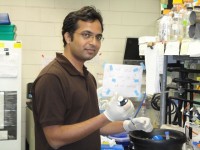 Ambuj Kumar Kushwaha
Ambuj Kumar Kushwaha
2008-2014
(Graduate Student)
Ambuj primarily worked on Mycobacterium smegmatis Ku protein, focusing on the role of its lysine-rich C-terminal domain. He found that M. smegmatis Ku, unlike previously described prokaryotic Ku proteins, binds DNA without free ends, and that it translocates from DNA ends to internal DNA sites. Ambuj graduated in December 2013. After postdoctoral research in the US and Singapore, Ambuj accepted an Assistant Professor position at Banaras Hindu University, India in 2019.
Publications:
Kushwaha, A. K., Deochand, D. K. and Grove, A. 2015. A moonlighting function of Mycobacterium smegmatis Ku in zinc homeostasis? Protein Sci. 24, 253-263.
Grove, A., Kushwaha, A. K. and Nguyen, K. H. 2015. Determining the role of metal binding in protein cage assembly. Methods Mol. Biol. 1252, 91-100.
Kushwaha, A. K. and Grove, A. 2013. Mycobacterium smegmatis Ku binds DNA without free ends. Biochem. J. 456, 275-282. Accompanied by Author Podcast.
Kushwaha, A. K. and Grove, A. 2013. C-terminal low-complexity sequence repeats of Mycobacterium smegmatis Ku modulate DNA binding. Biosci. Rep. 33, e00016.
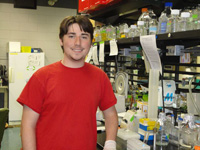 Brian Mackel
Brian Mackel
2012-2013
(Undergraduate Student)
Brian contributed to a project concerning oxidative stress responses in the soil bacterium Streptomyces coelicolor, a member of a species best known for production of antibiotics and other metabolites. Brian was accepted to Medical School at LSUHSC New Orleans.
Publication:
Huang, H., Mackel, B. J. and Grove, A. 2013. Streptomyces coelicolor encodes a urate-responsive transcriptional regulator with homology to PecS from plant pathogens. J. Bacteriol. 195, 4954-4965.
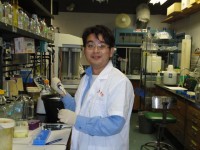 Hao Huang
Hao Huang
2011-2013
(Graduate Student)
Hao’s main project concerned TamR, a transcription factor from Streptomyces coelicolor that regulates expression of genes involved in the citric acid cycle during oxidative stress. He also characterized S. coelicolor PecS, which is a homolog of a key transcriptional regulator from plant pathogens. Hao accepted a postdoctoral position at the Dana-Farber Cancer Institute/Harvard Medical School. In 2022, he joined Discovery Life Sciences.
Publications:
Huang, H., Sivapragasam, S. and Grove, A. 2015. The regulatory role of Streptomyces coelicolor TamR in central metabolism. Biochem. J. 466, 347-358.
Huang, H. and Grove, A. 2013. The transcriptional regulator TamR from Streptomyces coelicolor controls a key step in central metabolism during oxidative stress. Mol. Microbiol. 87, 1151-1166.
Huang, H., Mackel, B. J. and Grove, A. 2013. Streptomyces coelicolor encodes a urate-responsive transcriptional regulator with homology to PecS from plant pathogens. J. Bacteriol. 195, 4954-4965.
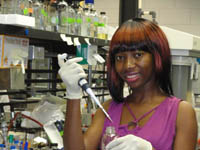 Emmanuela Onu
Emmanuela Onu
2011-2013
(Undergraduate Student)
Supported by the IMSD program, Emmanuela was working on a project that aims to delineate oxidative stress responses in Burkholderia species. Emmanuela enrolled in the Master of Public Health program at LSU New Orleans in fall 2015.
 Daniel DePaula
Daniel DePaula
2012-2013
(Undergraduate Student)
Daniel's project aimed to understand the process by which Deinococcus radiodurans Dps-1 protein assembles into an oligomeric structure. Daniel left to pursue his interest in psychology.
 Frances Arinze
Frances Arinze
Summer 2013
(Undergraduate Student)
Supported by the OSI REU program, Frances participated in a project aiming to understand oxidative stress responses in the plant pathogen Pectobacterium atrosepticum.
 Khoa Huynh Nguyen
Khoa Huynh Nguyen
2008-2013
(Graduate Student)
Khoa's project focused on the role of Deinococcus radiodurans Dps proteins in oxidative stress. Khoa analyzed assembly of Dps-1 and its association with genomic DNA, and he contributed to an analysis of DNA binding and cellular localization of Dps-2. Khoa accepted a position as instructor in the Department of Biological Sciences at LSU immediately after graduation.
Publications:
Grove, A., Kushwaha, A. K. and Nguyen, K. H. Determining the role of metal binding in protein cage assembly. 2015. Methods Mol. Biol. 1252, 91-100.
Reon, B. J., Nguyen, K. H., Bhattacharyya, G. and Grove, A. 2012. Functional comparison of Deinococcus radiodurans Dps proteins suggests distinct in vivo roles. Biochem. J. 447, 381-391.
Nguyen, K. H. and Grove, A. 2012. Metal binding at the Deinococcus radiodurans Dps-1 N-terminal metal site controls dodecameric assembly and DNA binding. Biochemistry 51, 6679-6689.
Nguyen, K. H., Smith, L. T., Xiao, L., Bhattacharyya, G. and Grove, A. 2012. On the stoichiometry of Deinococcus radiodurans Dps-1 binding to duplex DNA. Proteins 80, 713-721.
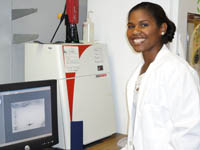 Tiffany L. Lemon
Tiffany L. Lemon
2009-2013
(Undergraduate Student)
Tiffany graduated in May 2013 with College Honors, having completed an Honors Thesis focusing on a transcription factor from Vibrio vulnificusthat is predicted to regulate expression of an efflux pump. Tiffany graduated from the MSPH program at Emory University Rollins School of Public Health in May 2016 and enrolled in the PhD program in Population Health Sciences at the Harvard T. H. Chan School of Public Health. She joined Arizona State University in 2023 as an Assistant Professor.
Publication:
Bhattacharyya, N., Lemon, T. L. and Grove, A. 2019. A role for Vibrio vulnificus PecS during hypoxia. Sci. Rep. 9, 2797.
Presentation:
Lemon, T. and Grove, A. 2012. Characterization of a MarR homolog in Vibrio vulnificus. 2012 Experimental Biology Meeting. San Diego, CA, April 2012. FASEB J. 26, 740.5.
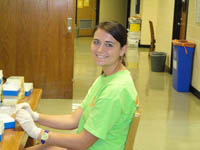 Katie Herbert
Katie Herbert
2011-2012
(Undergraduate Student)
The objective of Katie's project was to clone the gene encoding a drug efflux pump from Burkholderia thailandensis to be able to determine its substrate specificity.
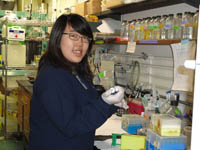 Katie Park
Katie Park
2012-2013
(High School Student)
While attending Baton Rouge Magnet High School, Katie visited the lab to gather material for a senior thesis. She started college in fall 2013.
 Brandon Bauerle
Brandon Bauerle
2008-2012
(Undergraduate Student)
Brandon contributed to understanding oxidative stress resistance in Deinococcus radiodurans, focusing on the role of urate as an antioxidant. After graduation, Brandon enrolled in Medical School at LSUHSC Shreveport.
Presentation:
Bauerle, B., Perera I. C. and Grove, A. 2011. Comparison of Deinococcus radiodurans HucR and uricase promoter activities. 2011 Experimental Biology Meeting. Washington, DC, April 2011. FASEB J. 25, 699.1.
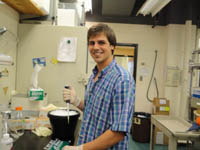 Corey Area
Corey Area
2008-2012
(Undergraduate Student)
Corey's project was to understand the mechanisms by which histone-like protein Hlp is upregulated in Mycobacterium smegmatis; Hlp is upregulated in dormancy, which is a physiological state also characteristic of M. tuberculosis. Corey graduated in May 2012 and enrolled in Medical School.
 Zachary Stewart
Zachary Stewart
2009-2012
(Undergraduate Student)
Zach contributed to a project dealing with MarR family transcription factors and their regulation of multidrug efflux pumps in Burkholderia thailandensis. Zach enrolled in Medical School at LSUHSC New Orleans after his graduation in May 2012.
 Michael Paternostro
Michael Paternostro
2011-2012
(Undergraduate Student)
Michael's project was to understand ligand-binding by a MarR family transcription factor from Burkholderia thailandensis. Michael graduated in May 2012 with plans of attending Medical School.
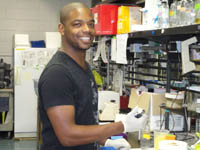 Kendall Knight
Kendall Knight
2011
(Undergraduate Student)
Kendall participated in a project aiming to understand the mechanism of function of Deinococcus radiodurans Dps-2. He was supported by the IMSD program.
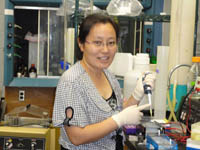 LiJuan Xiao
LiJuan Xiao
2005-2011
(Postdoctoral Fellow)
LiJuan's project concerned the function of the yeast high mobility group protein HMO1. She established that HMO1 negatively regulates its own expression, and that HMO1 gene activity is repressed on inactivation of the Target of Rapamycin (TOR) kinase. She also analyzed the function of HMO1 in DNA double strand break repair. After a brief stay at Mount Sinai School of Medicine in New York, LiJuan joined Baylor College of Medicine. In 2016, she accepted a position at Labcorp in Phoenix, AZ.
Publications:
Panday, A., Gupta, A., Srinivasa, K., Xiao, L., Smith, M. D. and Grove, A. 2017. DNA damage regulates direct association of TOR kinase with the RNA polymerase II-transcribed HMO1 gene. Mol. Biol. Cell. 28, 2449-2459.
Panday, A., Xiao, L., Gupta, A. and Grove, A. 2017. Control of DNA end resection by yeast Hmo1p affects efficiency of DNA end-joining. DNA Repair 53, 15-23.
Panday, A., Xiao, L. and Grove, A. 2015. Yeast high mobility group protein HMO1 stabilizes chromatin and is evicted during repair of DNA double strand breaks. Nucleic Acids Res. 43, 5759-5770.
Xiao, L. and Grove, A. 2013. Role of HMGB proteins in coordinating ribosomal protein and ribosomal RNA gene expression in response to TOR signaling. In: Advances in Genome Science: Probing intracellular regulation (C. Néri, ed.). Vol. 2, pp. 155-175. Bentham Science.
Nguyen, K. H., Smith, L. T., Xiao, L., Bhattacharyya, G. and Grove, A. 2012. On the stoichiometry of Deinococcus radiodurans Dps-1 binding to duplex DNA. Proteins 80, 713-721.
Xiao, L., Kamau, E., Donze, D. and Grove, A. 2011. Expression of yeast high mobility group protein HMO1 is regulated by TOR signaling. Gene 489, 55-62.
Xiao, L., Williams, A. M. and Grove, A. 2010. The C-terminal domain of yeast high mobility group protein HMO1 mediates lateral protein accretion and in-phase DNA bending. Biochemistry 49, 4051–4059.
Xiao, L. and Grove, A. 2009. Coordination of ribosomal protein and ribosomal RNA gene expression in response to TOR signaling. Curr. Genomics 10, 198-205.
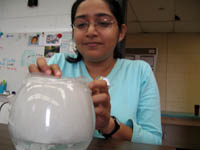 Sreerupa Ray
Sreerupa Ray
2006-2011
(Graduate student)
Sreerupa analyzed the function of the yeast high mobility group protein HMO2, a component of the chromatin remodeling complex INO80. She reported its unusual ability to bind DNA ends and analyzed the functional roles of individual protein domains. After graduation, she accepted a postdoctoral position at MD Anderson Cancer Center, and she moved to Yale University in 2013. In 2017, she accepted a faculty position at Linfield College, OR.
Publications:
Ray, S. and Grove, A. 2012. Interaction of Saccharomyces cerevisiae HMO2 domains with distorted DNA. Biochemistry 51, 1825-1835.
Ray, S. and Grove, A. 2009. The yeast high mobility group protein HMO2, a subunit of the chromatin remodeling complex INO80, binds DNA ends. Nucleic Acids Res. 37, 6389–6399.
Wowor, A. J., Datta, K., Brown, H. S., Thompson, G. S., Ray, S., Grove, A. and LiCata, V. J. 2010. Thermodynamics of the DNA structural selectivity of the Pol I DNA polymerases from Escherichia coli and Thermus aquaticus. Biophys. J. 98, 3015-3024.
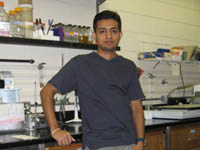 Inoka Perera
Inoka Perera
2007-2010
(Graduate student)
Inoka characterized DNA- and ligand-binding by the MarR family transcriptional regulators HucR and PecS, identifying the ligand-binding site and documenting the existence of a family of MarR homologs with a conserved urate-binding signature. Inoka graduated in August 2010 and joined the faculty in the Department of Zoology at University of Colombo, Sri Lanka, where he rose to the rank of Professor.
Publications:
Deochand, D. K., Perera, I. C., Crochet, R. B., Gilbert, N. C., Newcomer, M. E. and Grove, A. 2016. Histidine switch controlling pH-dependent protein folding and DNA binding in a transcription factor at the core of synthetic network devices. Mol. BioSyst. 12, 2417-2426.
Perera, I. C. and Grove, A. 2011. MarR homologs with urate-binding signature. Protein Sci. 20, 621-629.
Perera, I. C. and Grove, A. 2010. Urate is a ligand for the transcriptional regulator PecS. J. Mol. Biol. 390, 571-583.
Perera, I. C. and Grove, A. 2010. Molecular mechanisms of ligand-mediated attenuation of DNA binding by MarR family transcriptional regulators. J. Mol. Cell Biol. 2, 243-254.
Perera, I. C., Lee, Y.-H., Wilkinson, S. P. and Grove, A. 2009. Mechanism for attenuation of DNA binding by MarR family transcriptional regulators by small molecule ligands. J. Mol. Biol. 390, 1019-1029.
 Brian Reon
Brian Reon
2006-2010
(Undergraduate/Graduate student)
Brian completed an Honors Thesis in 2008, documenting the cloning and characterization of the stress-response protein Dps-2 from Deinococcus radiodurans. He continued on this project as a Masters student, focusing on its assembly and cellular localization. Brian subsequently earned his MD-PhD from University of Virginia Health Science Center, Charlottesville and accepted a residency at University of Pittsburgh Medical Center.
Publication:
Reon, B. J., Nguyen, K. H., Bhattacharyya, G. and Grove, A. 2012. Functional comparison of Deinococcus radiodurans Dps proteins suggests distinct in vivo roles. Biochem. J. 447, 381-391.
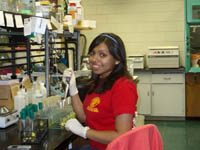 Wedad Rahman
Wedad Rahman
2006-2010
(Undergraduate Student)
Wedad's Honors Thesis focused on the mechanism by which the yeast High Mobility Group protein HMO2 interacts with distorted DNA. After graduation in May 2010, Wedad started Medical School at LSUHSC New Orleans.
Presentations:
Rahman, W., Ray, S. and Grove, A. 2010. Interactions of yeast HMO2 with distorted DNA. 2010 Experimental Biology Meeting. Anaheim, CA, April 2010. FASEB J. 24, 876.11.
Rahman, W., Ray, S. and Grove, A. 2009. Identifying amino acid residues in the yeast high mobility group protein HMO2 that are important for DNA binding. 2009 Experimental Biology Meeting. New Orleans, LA, April 2009. FASEB J. 23, 701.3.
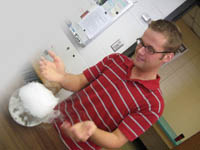 Luke Smith
Luke Smith
2008-2009
(Research Associate)
Luke contributed to a project aiming to define the mechanism of DNA binding by Dps-1 from D. radiodurans. Luke accepted a position at the University of Chicago with long-term plans of enrolling in graduate school.
Publication:
Nguyen, K. H., Smith, L. T., Xiao, L., Bhattacharyya, G. and Grove, A. 2012. On the stoichiometry of Deinococcus radiodurans Dps-1 binding to duplex DNA. Proteins 80, 713-721.
 Cara Bevinetto
Cara Bevinetto
2007-2009
(Undergraduate Student)
Cara completed her Honors Thesis on a project pertaining to mechanisms of oxidative stress resistance in Deinococcus radiodurans, focusing on the role of the nucleoid-associated protein HU. Cara graduated in May 2009 and enrolled in Medical School at LSUHSC New Orleans in Fall 2009.
 Teesta Jain
Teesta Jain
2005-2009
(Graduate Student)
Teesta worked on an unusual eukaryotic-type topoisomerase from Pseudomonas aeruginosa, including the mechanism by which this enzyme is inhibited by fluoroquinolone drugs. She accepted a postdoctoral position at UC Davis in Spring 2009. After working for a number of years in sales and business development, she accepted a Lecturer position at City Colleges of Chicago in 2018.
Publication:
Jain, T., Roper, B. J. and Grove, A. 2009. A Functional Type I Topoisomerase from Pseudomonas aeruginosa. BMC Mol. Biol. 10, 23.
 Jonathan Vignes
Jonathan Vignes
2007-2008
(Undergraduate Student)
Jonathan worked on a project aiming to define responses to oxidative stress in Deinococcus radiodurans.
 Jesse Stephan
Jesse Stephan
Summer 2008
(Undergraduate Student)
Jesse participated in the analysis of vaccinia topoisomerase and the mechanism by which it is inhibited by fluoroquinolones. Jesse was supported by the LBRN summer research program.
 Anirban Mukherjee
Anirban Mukherjee
2002-2007
(Graduate Student)
Anirban worked on histone-like proteins from both Mycobacterium smegmatis and from the thermophile Thermotoga maritima. Using both in vitroDNA binding assays and immunofluorescence, he described the mode of DNA binding by these proteins and their effect on nucleoid organization in vivo. Anirban accepted a postdoctoral position at the MD Anderson Cancer Center and moved with the lab to University of Texas at Austin.
Publications:
Mukherjee, A., DiMario, P. J. and Grove, A. 2009. Mycobacterium smegmatis histone-like protein Hlp is nucleoid associated. FEMS Microbiol. Lett. 291, 232-240.
Mukherjee, A., Bhattacharyya, G. and Grove, A. 2008. The C-terminal domain of Mycobacterium smegmatis histone-like protein mediates DNA end-joining and is required for transcriptional repression. Biochemistry 47, 8744-8753.
Mukherjee, A., Sokunbi, A. O. and Grove, A. 2008. DNA protection by histone-like protein HU from the hyperthermophilic eubacterium Thermotoga maritima. Nucleic Acids Res. 36, 3956-3968.
 Kaylin Smith
Kaylin Smith
2004-2007
(Undergraduate Student)
Kaylin contributed to the analysis of uric acid as an antioxidant in D. radiodurans. Kaylin was accepted to medical school at LSUHSC Shreveport.
Rebeca Bull
Summer 2007
(Undergraduate Student)
Supported by the LBRN summer research program, Rebeca participated in analysis of oxidative stress responses in E. coli.
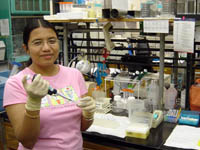 Gargi Bhattacharyya
Gargi Bhattacharyya
2000-2002 and 2005-2007
(Graduate Student)
Gargi's main contribution was to determine the mode of DNA binding by the Deinococcus radiodurans-encoded DNA binding protein Dps-1 and its role in DNA compaction. Gargi graduated in May 2007 and accepted a position at East India Pharmaceutical Works Ltd., Kolkata, IN. She subsequently returned to the US for postdoctoral research. In 2020, she accepted a position as Technical Sales Manager at INDIGO Biosciences, Inc., State College, PA.
Publications:
Reon, B. J., Nguyen, K. H., Bhattacharyya, G. and Grove, A. 2012. Functional comparison of Deinococcus radiodurans Dps proteins suggests distinct in vivo roles. Biochem. J. 447, 381-391.
Nguyen, K. H., Smith, L. T., Xiao, L., Bhattacharyya, G. and Grove, A. 2012. On the stoichiometry of Deinococcus radiodurans Dps-1 binding to duplex DNA. Proteins 80, 713-721.
Mukherjee, A., Bhattacharyya, G. and Grove, A. 2008. The C-terminal domain of Mycobacterium smegmatis histone-like protein mediates DNA end-joining and is required for transcriptional repression. Biochemistry 47, 8744-8753.
Bhattacharyya, G. and Grove, A. 2007. The N-terminal extensions of Deinococcus radiodurans Dps-1 mediates DNA major groove interactions as well as assembly of the dodecamer. J. Biol. Chem. 282, 11921-11930.
Kim, S.-G., Bhattacharyya, G., Grove, A. and Lee, Y.-H. 2006. Crystal Structure of Dps-1, a Functionally Distinct Dps Protein from Deinococcus radiodurans. J. Mol. Biol. 361, 105-114.
 Ben Roper
Ben Roper
2003-2007
(Undergraduate Student)
Ben made significant contributions to the characterization of Topoisomerase I from Pseudomonas aeruginosa. Ben graduated in May 2007 and started medical school at UTMB, Galveston.
Publication:
Jain, T., Roper, B. J. and Grove, A. 2009. A Functional Type I Topoisomerase from Pseudomonas aeruginosa. BMC Mol. Biol. 10, 23.
Presentation:
Jain, T., Roper, B. and Grove, A. 2007. Pseudomonas aeruginosa encodes a functional type IB topoisomerase. 2007 Experimental Biology Meeting. FASEB J. 21, A659.
 Alan Williams
Alan Williams
2007
(Undergraduate student)
Alan contributed to analysis of the yeast high mobility group protein HMO1, supported
by the IMSD program. Alan graduated in May 2007 and was accepted to the Postbaccalaureate
program at NIH. Alan subsequently earned his PhD from Yale University as a recipient
of an NSF Graduate Research Fellowship. In 2016, he joined Cellectis, NY, as a postdoctoral
fellow.
Publication:
Xiao, L., Williams, A. M. and Grove, A. 2010. The C-terminal domain of yeast high mobility group protein HMO1 mediates lateral protein accretion and in-phase DNA bending. Biochemistry 49, 4051–4059.
Presentations:
Xiao, L., Williams, A. M. and Grove, A. 2009. The Yeast High Mobility Group Protein HMO1 Facilitates DNA End-Joining and Functions in DNA Double Strand Break Repair. ASBMB 2009. New Orleans. A: 3272.
Williams, A. and Grove, A. 2007. The yeast high mobility group protein, HMO1, facilitates DNA end-joining. 2007 Experimental Biology Meeting. FASEB J. 21, A291.
Divya Seth
2007
(Undergraduate Student)
Divya was a BIOL3999 research student working on oxidative stress responses in E. coli.
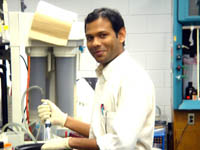 Kishore Shantidas
Kishore Shantidas
2005-2006
(Graduate Student)
Kishore, who joined the lab in 2005 as a graduate student and worked on mechanisms of responses to oxidative stress, left in 2006 to pursue other career paths.
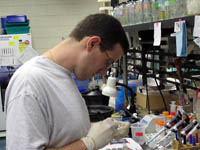 Nick Tsihlis
Nick Tsihlis
2000-2006
(Graduate Student)
Nick's project dealt with the role of DNA flexibility in assembly of the yeast RNA polymerase III recruitment factor TFIIIB. Nick joined Northwestern University School of Medicine as a postdoctoral researcher in July 2006 and was subsequently promoted to Research Assistant Professor. In 2016, he moved with the lab to UNC School of Medicine as a Research Associate Professor. Since 2021, Nick has been a Professor at University of Virginia School of Medicine.
Publications:
Tsihlis, N. D. and Grove, A. 2006. The Saccharomyces cerevisiae RNA polymerase III recruitment factor subunits Brf1 and Bdp1 impose a strict sequence preference for the downstream half of the TATA box. Nucleic Acids Res. 34, 5585-5593.
Kamau, E., Tsihlis, N. D., Simmons, L. A., and Grove, A. 2005. Surface salt bridges modulate DNA site size of bacterial histone-like HU proteins. Biochem. J. 250, 49-55.
 Sean Hebert
Sean Hebert
2002-2006
(Undergraduate Student)
Sean made significant contributions to the analysis of HU from the thermophilic eubacterium Thermotoga maritima. After graduation in May 2006, Sean started medical school at LSUHSC, Shreveport.
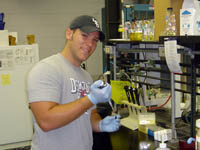 Kevin Ricks
Kevin Ricks
2005-2006
(Undergraduate Student)
Kevin was contributing to the characterization of the yeast High Mobility Group protein, HMO1. Kevin graduated in May 2006 with plans of going to medical school.
Jen Hicks
2005
(Undergraduate Student)
Jen was contributing to the characterization of the yeast High Mobility Group protein, HMO1. Jen graduated in December 2005 with plans of going to graduate school.
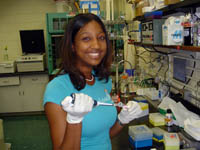 Melannie White
Melannie White
2005
(Undergraduate Student)
Melannie was contributing to the characterization of the yeast High Mobility Group protein, HMO2. Melannie graduated in December 2005 with plans of going to medical school.
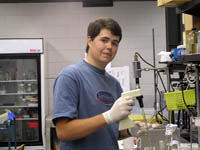 Kevin Bauerle
Kevin Bauerle
2003-2005
(Undergraduate Student)
Supported by the HHMI research program, Kevin analyzed DNA binding and domain-domain interactions in the yeast High Mobility Group protein, HMO1. Kevin enrolled in the MD-PhD program at University of Colorado in Fall 2005. After a residency at Beth Israel Deaconess Medical Center, Kevin joined Washington University in St. Louis as a Clinical Fellow in 2014; in 2018, he accepted a position at St. John's Mercy Hospital.
Publications:
Bauerle, K. T., Kamau, E. and Grove, A. 2006. Interactions between the N- and C-terminal domains of the Saccharomyces cerevisiae high mobility group protein HMO1 are required for DNA bending. Biochemistry 45, 3635-3645.
Kamau, E., Bauerle, K. T. and Grove, A. 2004. The Saccharomyces cerevisiae High Mobility Group Box protein HMO1 contains two functional DNA-binding domains. J. Biol. Chem. 279, 55234-55240.
Presentations:
Bauerle, K. T., Kamau, E. and Grove, A. 2005. Domain-domain interactions in the Saccharomyces cerevisiae HMGB protein HMO1. FASEB J.19(4), A296.
Bauerle, K. T., Kamau, E. and Grove, A. 2004. Domain-domain interactions in the Saccharomyces cerevisiae HMGB protein HMO1. 18th Annual Gibbs Conference on Biothermodynamics. Carbondale, IL, October 2004.
 Steven Wilkinson
Steven Wilkinson
2000-2005
(Graduate Student)
Steven analyzed a novel uric acid-responsive transcriptional regulator from Deinococcus radiodurans. After graduation, Steven accepted a postdoctoral position at University of California, San Diego; he subsequently joined Biomatrica in San Diego. In 2014, he accepted a faculty position at Cal Poly, San Luis Obispo, CA.
Publications:
Perera, I. C., Lee, Y.-H., Wilkinson, S. P. and Grove, A. 2009. Mechanism for attenuation of DNA binding by MarR family transcriptional regulators by small molecule ligands. J. Mol. Biol. 390, 1019-1029.
Bordelon,T., Wilkinson, S. P., Grove, A. and Newcomer, M. E. 2006. The crystal structure of the transcriptional regulator HucR from Deinococcus radiodurans reveals a repressor preconfigured for DNA binding. J. Mol. Biol. 360, 168-177.
Wilkinson, S. P. and Grove, A. 2006. Ligand-responsive transcriptional regulation by members of the MarR family of winged helix proteins. Curr. Issues Mol. Biol. 8, 51-62.
Wilkinson, S. P. and Grove, A. 2005. Negative cooperativity of uric acid binding to the transcriptional regulator HucR from Deinococcus radiodurans. J. Mol. Biol. 350, 617-630.
Grove, A. and Wilkinson, S. P. 2005. Differential DNA binding and protection by dimeric and dodecameric forms of the ferritin homolog Dps from Deinococcus radiodurans. J. Mol. Biol. 347, 495-508.
Wilkinson, S. P. and Grove, A. 2004. HucR, a novel uric acid responsive member of the MarR family of transcriptional regulators from Deinococcus radiodurans. J. Biol. Chem. 279, 51442-51450.
 Edwin Kamau
Edwin Kamau
2001-2005
(Graduate Student)
Edwin described DNA-binding properties of a yeast High Mobility Group protein, HMO1. He also discovered a novel interaction between Vaccinia topoisomerase I and fluoroquinolone antibiotics. Edwin became a commissioned officer in the US Army, stationed at the Walter Reed Army Medical Research Institute, MD. He subsequently became Director of the Malaria Drug Resistance Laboratory at the US Army Medical Research Unit Kenya.
Publications:
Xiao, L., Kamau, E., Donze, D. and Grove, A. 2011. Expression of yeast high mobility group protein HMO1 is regulated by TOR signaling. Gene 489, 55-62.
Bauerle, K. T., Kamau, E. and Grove, A. 2006. Interactions between the N- and C-terminal domains of the Saccharomyces cerevisiae high mobility group protein HMO1 are required for DNA bending. Biochemistry 45, 3635-3645.
Kamau, E., Tsihlis, N. D., Simmons, L. A., and Grove, A. 2005. Surface salt bridges modulate DNA site size of bacterial histone-like HU proteins. Biochem. J. 390, 49-55.
Kamau, E., Bauerle, K. T. and Grove, A. 2004. The Saccharomyces cerevisiae High Mobility Group Box protein HMO1 contains two functional DNA-binding domains. J. Biol. Chem. 279, 55234-55240.
Kamau, E. and Grove, A. 2004. Fluoroquinolone-dependent DNA supercoiling by Vaccinia topoisomerase I. J. Mol. Biol. 342, 479-487.
 Robert Edwards
Robert Edwards
2004
(Undergraduate Student)
Robert participated in the analysis of the DNA binding protein Dps from Deinococcus radiodurans. Robert graduated in December 2004 and started Dental School at LSU Health Sciences Center. Since graduating in 2009, Robert has been practicing in Baton Rouge.
 Sharmistha Ghosh
Sharmistha Ghosh
2000-2004
(Graduate student)
Sharmistha analyzed DNA binding by the HU homolog encoded by Deinococcus radiodurans, showing that D. radiodurans HU displays a unique mode of interaction with its favorite substrate, the four-way DNA junction. After graduation in December 2004, Sharmistha joined Harvard Medical School as a postdoctoral associate. She subsequently moved to the pharmaceutical industry; in 2022, she joined Aeglea BioTherapeutics, Austin, TX.
Publications:
Ghosh, S. and Grove, A. 2006. The Deinococcus radiodurans-encoded HU protein has two DNA-binding domains. Biochemistry 45, 1723-1733.
Chen, C., Ghosh, S. and Grove, A. 2004. Substrate specificity of Helicobacter pylori HU is determined by insufficient stabilization of DNA flexure points. Biochem. J. 383, 343-351.
Ghosh, S. and Grove, A. 2004. Histone-like protein HU from Deinococcus radiodurans binds preferentially to four-way DNA junctions. J. Mol. Biol. 337, 561-571.
 Alice Simmons
Alice Simmons
2000-2003
(Research Associate)
Alice was our dedicated lab manager, keeping all of us from destroying everything. She supervised student workers and contributed to our analysis of Bacillus subtilis HU. Alice accepted another position as Research Associate in the department.
Publication:
Kamau, E., Tsihlis, N. D., Simmons, L. A., and Grove, A. 2005. Surface salt bridges modulate DNA site size of bacterial histone-like HU proteins. Biochem. J. 390, 49-55.
Lindah Wabuyele
2004
(Undergraduate student)
Lindah's project involved the isolation from Deinococcus radiodurans cell lysates of proteins with affinity for four-way junction DNA. Lindah graduated in May 2004 and started graduate school at Rensselaer Polytechnic Institute, Troy, NY.
Caroline Bercier
2003-2004
(Undergraduate student)
Caroline participated in a project aiming to inactivate the gene encoding a transcriptional regulator, HucR, from Deinococcus radiodurans. Caroline graduated from the MPH Genetics program at University of Washington and subsequently from its Law School.
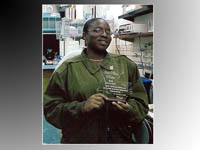 Abimbola Sokunbi
Abimbola Sokunbi
2002-2003
(Undergraduate student)
Supported by the HHMI and LBRN research programs, Abby worked on HU from Thermotoga maritima. Using DNA cyclization assays, she demonstrated its ability to bend DNA as well as its ability to promote ligation of short DNA fragments. She also initiated an analysis DNA supercoiling. Abby earned her M.D. from Texas A & M University.
Publication:
Mukherjee, A., Sokunbi, A. O. and Grove, A. 2008. DNA protection by histone-like protein HU from the hyperthermophilic eubacterium Thermotoga maritima. Nucleic Acids Res. 36, 3956-3968.
Presentations:
Sokunbi, A. and Grove, A. 2003. Opposites Do Not Attract: Positive and Negative Supercoils by Thermotoga maritima. 7th Annual LS-LAMP Student Research Conference. New Orleans, LA, November 2003.
Sokunbi, A. and Grove, A. 2003. Does size really matter? 6th Annual LS-LAMP Student Research Conference. Baton Rouge, LA, November 2003.
 Christina Chen
Christina Chen
1999-2003
(Undergraduate student)
Christina participated in the analysis of HU from the human pathogen Helicobacter pylori. After graduation, Christina went to Medical School at LSUHSC, New Orleans.
Publication:
Chen, C., Ghosh, S. and Grove, A. 2004. Substrate specificity of Helicobacter pylori HU is determined by insufficient stabilization of DNA flexure points. Biochem. J. 383, 343-351.
Presentation:
Chen, C. and Grove, A. 2003. Characterization of the histone-like HU protein from Helicobacter pylori. 225th ACS National Meeting. New Orleans, LA, March 2003. Abstract no. CHED 853.
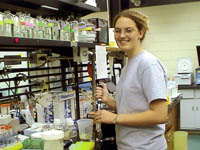 Jill Sayes
Jill Sayes
1999-2003
(Undergraduate student)
Jill was using in vitro selection techniques to select for catalytic RNA specific for the carboxylation of biotin. After working as a Research Associate at LSU after graduation, Jill earned her PhD from Texas A&M University. After a few years in a faculty position at University of St. Thomas in Houston, Jill accepted a position at University of North Texas.
Presentations:
Sayes, J., Wilkinson, S. P., Strongin, R., Waldrop, G. L. and Grove, A. 2003. Developing RNA catalysts for the carboxylation of biotin. 225th ACS National Meeting. New Orleans, LA, March 2003. Abstract no. CHED 874.
Sayes, J., Grove, A., Johnson, L. and Strongin, R. 2002. Developing RNA catalysts for the carboxylation of biotin. 223rd ACS National Meeting. Orlando, FL, April 2002. Abstract no. CHED 307.
Sayes, J. and Grove, A. 2001. Developing RNA catalysts for the carboxylation of biotin. 221st ACS National Meeting. San Diego, CA, April 2001. Abstract no. CHED 572.
 Tatiana Saavedra
Tatiana Saavedra
2000
(Undergraduate student)
Supported by the LS-LAMP research program, Tatiana participated in defining molecular determinants of DNA site size for the HU homolog TF1. Tatiana went to Medical School at LSUHSC, New Orleans.
Publication:
Grove, A. and Saavedra, T. C. 2002. The role of surface-exposed lysines in wrapping DNA about the bacterial histone-like protein HU. Biochemistry 41, 7597-7603.
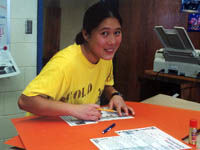 Lynette Lim
Lynette Lim
Summer 2000
(Undergraduate student)
Supported by the HHMI research program, Lynette participated in defining DNA-binding
properties of HU from Thermotoga maritima. After graduation, Lynette accepted a position as Research Associate at Johns Hopkins
University. She subsequently earned her Ph.D. from National University of Singapore.
Publication:
Grove, A. and Lim, L. 2001. High-affinity DNA binding of HU protein from the hyperthermophile Thermotoga maritima. J. Mol. Biol. 311, 491-502.
Presentations:
Lim, L and Grove, A. 2001. Unusual characteristics found in bacterial chromatin of hyperthermophile Thermotoga maritima. National Conference on Undergraduate Research 2001. Lexington KY, March 2001.
Lim, L and Grove, A. 2000. Unusual characteristics found in bacterial chromatin of hyperthermophile Thermotoga maritima. 11th Annual Argonne Symposium for Undergraduates. Argonne, IL, November 2000.
Lim, L. and Grove, A. 2000. Unusual characteristics found in bacterial chromatin of hyperthermophile Thermotoga maritima. 40th Annual Meeting of The American Society for Cell Biology. San Francisco, CA, December 2000. Mol. Biol. Cell 11S, 440a.
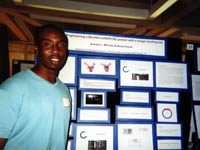 Karwin McCain
Karwin McCain
Summer 2001
(Undergraduate student)
Karwin's project concerned Bacillus subtilis HU.
Katie Wolfe
1999-2000
(Undergraduate student)
Kelly Flynn
1999-2000
(Undergraduate student)
 Randy Ellis
Randy Ellis
2001-2002
(Undergraduate student)